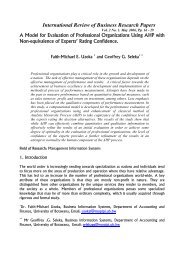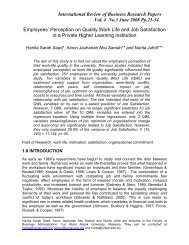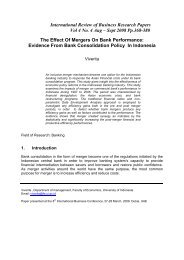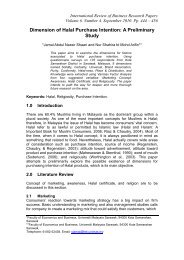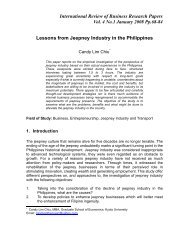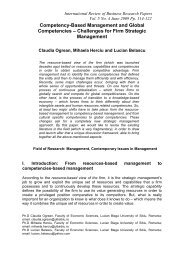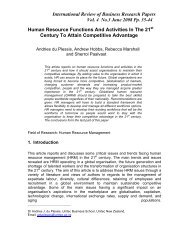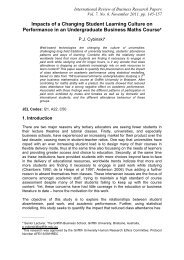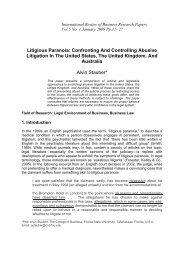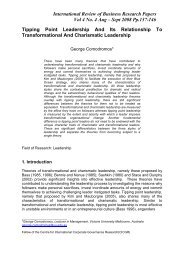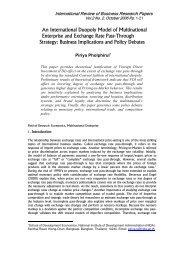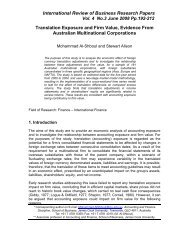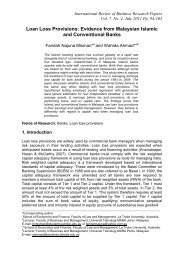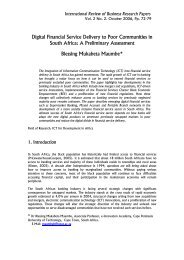Dividend Policy Of Pakistani Firms :Trends and Determinants
Dividend Policy Of Pakistani Firms :Trends and Determinants
Dividend Policy Of Pakistani Firms :Trends and Determinants
Create successful ePaper yourself
Turn your PDF publications into a flip-book with our unique Google optimized e-Paper software.
International Review of Business Research Papers<br />
Vol. 3 No. 3 August 2007 Pp. 242-254<br />
<strong>Dividend</strong> <strong>Policy</strong> <strong>Of</strong> <strong>Pakistani</strong> <strong>Firms</strong> :<strong>Trends</strong> <strong>and</strong><br />
<strong>Determinants</strong><br />
Shammyla Naeem * <strong>and</strong> Mohammad Nasr **<br />
We provide here a study of <strong>Pakistani</strong> <strong>Firms</strong> registered on the Karachi Stock<br />
Markets. We have examined many determinant variables of the dividend policy to<br />
shed light on the dividend trends of firms in Pakistan as an emerging market. Our<br />
sample is comprised of 108 companies that have been listed on Karachi stock<br />
exchange during 1999-2004. The starting point in our research has been an<br />
observation that most of the <strong>Pakistani</strong> firms were reluctant in dividend payments.<br />
Mostly, firms either did not pay dividends or their dividend per share ranged<br />
between 0 - 2.5 Rupees per share. We find that the non-financial sector has<br />
higher average dividend payout than the financial sector. Sector wise analysis<br />
indicates that Oil & Gas Exploration, Oil & Gas Marketing <strong>and</strong> Power Generation &<br />
Distribution Sectors have higher average dividend payments. We find evidence<br />
that former dividends play a major role in determining current dividends. For the<br />
whole sample, we find that firms with greater profitability have higher dividend<br />
payouts. We also find that investment opportunities, liquidity <strong>and</strong> leverage are<br />
negatively related to dividend payout for the whole sample. We conclude from the<br />
research that when non-financial firms invest more in fixed assets their dividend<br />
payout is negatively affected by that. We find also that larger financial firms pay<br />
larger amount of dividends. But, when these firms have investment opportunities<br />
they retain profits.<br />
Field of Research: Corporate Finance<br />
1. Introduction<br />
“The harder we look at the dividend picture, the more it seems like a puzzle, with<br />
pieces that just don’t fit together” Fischer Black (1976). To solve this puzzle an<br />
untold number of scientific papers have been written; many of them lacking<br />
strong empirical support define the current state of financial economists’ attempts<br />
to explain the dividend phenomenon. Since Emerging equity markets add more<br />
pieces to the “dividend puzzle” we have tried to shed light on one of the emerging<br />
markets, Pakistan. The existent literature in this context is sparse <strong>and</strong> has<br />
* Shammyla Naeem is PhD student at COMSATS Institute of Information Technology, Islamabad,<br />
Pakistan. e-mail: shammylan@yahoo.com<br />
** Dr. Mohammad Nasr (CGA) is a Professor (under foreign faculty hiring program of higher<br />
Education Commission of Pakistan) at COMSATS Institute of Information Technology,<br />
Islamabad, Pakistan. e-mail: mohamed_ nasr@comsats.edu.pk
Naeem & Nasr 243<br />
inspired us to undertake a research on this theme, which is expected to guide the<br />
dividend policies of the corporate sectors in Pakistan.<br />
These are the issues we attempt to address:<br />
• To study the trends in the dividend payment of <strong>Pakistani</strong> corporate firms.<br />
• To identify the prominent variables influencing the dividend policies of the<br />
select companies <strong>and</strong> to examine the extent to which these variables<br />
maintain their relative dominance over the periods under study.<br />
• To study the non-financial <strong>and</strong> financial firms separately <strong>and</strong> examine<br />
which variables are influencing these firms.<br />
Focusing our analysis on the current data i-e 1999-2004 of companies listed on<br />
Karachi stock market, it gives a current picture of the scenario of dividend<br />
policies of <strong>Pakistani</strong> companies. Data for some variables was not available,<br />
which prevented us from incorporating other potential determinants of corporate<br />
dividend policy in Pakistan.<br />
Following the introduction the rest of the paper is organized as follows:<br />
Section 2 gives the literature review of previous researches. Section 3 discusses<br />
our selected sample, data sources, variables <strong>and</strong> methodology of the research.<br />
Section 4 covers the descriptive as well as qualitative analysis of dividend policy<br />
of <strong>Pakistani</strong> firms. Section 5 draws the conclusion <strong>and</strong> recommendations based<br />
on the analysis.<br />
2. Literature Review<br />
We have focused on the factors affecting dividend policies <strong>and</strong> their trends for<br />
firms listed on Karachi stock exchange. To get a comprehensive of the dividend<br />
policies as exercised in different countries of the world we need to go thorough<br />
review of many relevant dividend policies literature to help us underst<strong>and</strong> the<br />
significance of dividend policies, <strong>and</strong> hence add our contribution in this paper.<br />
Based on the earlier work done by different researchers, Fisher Black’s in 1976<br />
conclude that “dividends” is a puzzle. This conclusion is a motivation to study the<br />
subject in more detail, specially the factors that would be helpful in determining<br />
the dividend policy for Pakistan as a country of emerging economy. A study on<br />
emerging countries including Pakistan is done by Aivazian, Booth <strong>and</strong> Clearly<br />
(2003). They find that profitability <strong>and</strong> Investment opportunities play an important<br />
role in determination of dividends. Similarly Hu <strong>and</strong> Liu, (2005) conclude that<br />
there is a positive relationship between the current earnings of a company <strong>and</strong><br />
the cash dividend they pay, <strong>and</strong> a significant negative relationship between the<br />
debt to total assets <strong>and</strong> dividends. Also, an Industry analysis by Dhanani (2005)<br />
provides clear evidence that those companies in the financial <strong>and</strong> utility sectors<br />
243
Naeem & Nasr 244<br />
support the dividend signalling hypothesis more than their counterparts in other<br />
industrial, consumer <strong>and</strong> service industries. Japanese keiretsu firms are also<br />
found to cut dividends more often <strong>and</strong> respond to poor performance by cutting<br />
dividends more quickly than either U.S or independent firms according to<br />
Dewentner <strong>and</strong> Warther (1998). Higher revenue is another factor which<br />
negatively influences the dividends (Ramcharran 2001). However DeAngelo,<br />
DeAngelo <strong>and</strong> Skinner (1996) find no evidence of positive future earnings for<br />
firms increasing dividends where as Cash in excess of peer firms in their industry<br />
also have significant effect on dividend-increasing or repurchase firms Lie (2000).<br />
Some researchers have also focused on emerging markets like Glen,<br />
Karmokolias, Miller, <strong>and</strong> Shah, (1997); who examine dividend behaviour in<br />
emerging equity markets <strong>and</strong> found that firms often have a target dividend payout<br />
ratio like their developed country counterparts.<br />
In a comparative study on the dividend policy of Australian <strong>and</strong> Japanese firms<br />
Ho (2003) shows that Australian firms’ dividend policies are positively affected by<br />
size but their counterparts in Japan have them positively affected by the liquidity,<br />
while risk has a negative effect. The dominant favourable tax effect of dividends<br />
in Australia, <strong>and</strong> the positive size effect suggest that transactions cost is a key<br />
determinant of distributing payments to shareholders in Australia but not in<br />
Japan, possibly because of its relatively small sized firms.<br />
Another study about Egyptian firms shows that for non-actively traded firms, the<br />
accounting book value is important determinant for dividend policy. But, for<br />
actively traded firms, gearing ratio <strong>and</strong> the market to book value are more<br />
important determinant of dividend policy (Omran <strong>and</strong> Pointon, 2004). Whereas<br />
Holder, Langrehr <strong>and</strong> Hexter (1998) provide another important factor “corporate<br />
focus”; but it is negatively related to dividend payout ratios. Another study found<br />
on banks’ dividend policy is provided by Dickens, Casey, <strong>and</strong> Newman (2000).<br />
They show that there is a negative relationship between dividend yields <strong>and</strong><br />
investment opportunities, signalling, ownership, <strong>and</strong> risk <strong>and</strong> a positive<br />
relationship with size <strong>and</strong> dividend history (also see Omet, 2004). Barclay, Smith,<br />
Ross (1995) find investment opportunities <strong>and</strong> leverage where as Baker,<br />
Theodore, <strong>and</strong> Gary (2001) find that the pattern of past dividends, stability of<br />
earnings, <strong>and</strong> level of current <strong>and</strong> expected future earnings are the most<br />
important determinants of dividend decision; (also see Brav, Graham, Harvey,<br />
Michaely, 2005). Whereas, Fama <strong>and</strong> French (2001) state that the decline in the<br />
incidence of dividend payers is in part due to an increasing tilt of publicly traded<br />
firms toward the characteristics, small size, low earnings, <strong>and</strong> high growth, of<br />
firms that typically have never paid dividends,<br />
There are also other interesting articles like that of Alli, Khan, Ramirez (1993)<br />
who find that <strong>Firms</strong> experiencing high issue cost, high growth level, <strong>and</strong> high risk,<br />
244
Naeem & Nasr 245<br />
<strong>and</strong> experiencing a high level of capital expenditure pay low dividends. Grullon,<br />
Michaely <strong>and</strong> Swaminathan (2002) state that firms increasing dividends<br />
experience also a significant decline in their return on assets, which indicates a<br />
decline in systematic risk. An<strong>and</strong> (2004) results reveal that most of the firms that<br />
have target dividend payout ratio <strong>and</strong> dividend changes follow shift in the longterm<br />
sustainable earnings.<br />
This brief review of literature shows that factors influencing the corporate<br />
dividend policy, according to them, may substantially vary from country to country<br />
because of inconsistency or variation in legal, tax <strong>and</strong> accounting policy between<br />
countries.<br />
In view of these facts, the present study aims at identifying the factors/variables<br />
influencing corporate dividend policy in Pakistan.<br />
3. Data <strong>and</strong> Methodology<br />
For the purpose of identifying the factors affecting the dividend policy of <strong>Pakistani</strong><br />
firms, a sample of 108 firms listed on Karachi stock exchange during 1999–2004<br />
is taken. Out of the sample of 108 firms, 77 are non-financial <strong>and</strong> merch<strong>and</strong>ising<br />
<strong>and</strong> 31 belong to financial sector.<br />
Following Ho (2003) <strong>and</strong> Omran <strong>and</strong> Pointon (2004) we also use <strong>Dividend</strong> payout<br />
ratio defined as the dividend per share for a company divided by earning per<br />
share of that company, as our dependent variable. For the purpose of examining<br />
the affect of liquidity we will use current ratio which is calculated by dividing<br />
current assets by current liabilities (also see Omran <strong>and</strong> Pointon (2004)).<br />
We hypothesize that Liquidity of a firm has negative relationship with dividend<br />
payout. Debt ratio can be used as independent variable because when a firm has<br />
relatively high financial leverage, its dependence on external finance is<br />
increased, thus, has low dividend payout ratios. (Also see Aivazian, Booth, <strong>and</strong><br />
Cleary, 2003 <strong>and</strong> Ho, 2003).<br />
Higher revenue firms should have lower probability of bankruptcy, <strong>and</strong>, therefore,<br />
should be more likely to pay higher dividends; Barclay, Smith, <strong>and</strong> Watts, (1995).<br />
We also think that size of firms, measured by log of sales, has an important<br />
contribution in explaining dividend policy of <strong>Pakistani</strong> firms since Larger firms<br />
have better access to market <strong>and</strong> therefore able to pay higher dividends.<br />
Asset structure defined as total assets minus current assets divided by totals<br />
assets will be used to capture tangibility for non-financial firms <strong>and</strong> for financial<br />
firms change in total assets will be used. Investments in fixed assets for<br />
expansion purpose leave little out of profits to be paid to shareholders as<br />
245
Naeem & Nasr 246<br />
dividends. Therefore, we hypothesize these ratios to have a negative relationship<br />
with dividend policy. For example, Ramcharran (2001) also finds support that<br />
retentions (i.e. lower dividends) are associated with greater growth. (also see Ho,<br />
2003, Aivazian, Booth, <strong>and</strong> Cleary, 2003, Omran <strong>and</strong> Pointon, 2004).<br />
Like those by D'Souza <strong>and</strong> Saxena (1999), Aivazian, Booth, <strong>and</strong> Clearly (2003)<br />
<strong>and</strong> Barclay, Smith, <strong>and</strong> Watts, (1995) we also use the Market to Book value<br />
ratio (M/B) calculated by dividing the market price of a company by the book<br />
value per share of firm for capturing the effect of investment opportunities. We<br />
hypothesize a negative relationship between investment opportunities <strong>and</strong><br />
dividend payout ratio. The measure of profitability in our case is return on<br />
investments, which is calculated by dividing the net profits after taxes for the firm<br />
by the total assets <strong>and</strong> hypothesize it to be positively related to dividend payout<br />
ratio. A previous study showed also that return on capital employed has a<br />
positive relation with dividend policy. (Aivazian, Booth, <strong>and</strong> Cleary, 2003 <strong>and</strong> Ho<br />
2003).<br />
Previous year’s dividend may also be another independent variable to examine<br />
the effect of previous year’s dividend payout ratio on current year’s dividend<br />
payout ratio. This ratio has been used by many previous researches like Omet<br />
(2004). Looking at dividends pattern in general we find that firms have a<br />
tendency to follow the pattern of past dividends.<br />
For the purpose of estimating effect of our independent variables over the firm’s<br />
dividend policy we are using a regression model, which follows the methodology<br />
of Omet (2004), <strong>and</strong> Dickens, Casey <strong>and</strong> Newman (2000). We have also opted to<br />
use the Ordinary Least Squares method (OLS) <strong>and</strong> Generalized Least Square to<br />
investigate <strong>and</strong> analyse the factors affecting the dividend policy of <strong>Pakistani</strong><br />
firms.<br />
4. Analysis <strong>and</strong> Discussion<br />
4.1 <strong>Trends</strong> in <strong>Dividend</strong> Payout Ratio (DPO)<br />
From the figures in Appendix A we note that for the whole sample, as well as for<br />
the sub-sample of financial <strong>and</strong> non-financial firms, inconsistent trends in<br />
average dividend payout have been noticed which brings us to the conclusion<br />
that <strong>Pakistani</strong> firms have instability in dividend payments.<br />
4.2 <strong>Dividend</strong>s- Industry-wise Analysis<br />
Table 4.1 in Appendix A shows the average dividend paid by firms in different<br />
sectors under the period of study. The table shows that on average Oil & Gas<br />
Marketing <strong>and</strong> Oil & Gas Exploration have paid the highest amounts of dividend<br />
246
Naeem & Nasr 247<br />
in all years of our study. The Power Generation & Distribution sector also is<br />
paying heavy dividends compared to other sectors. In the Cement sector, the<br />
percentage increase is over-all positive till 2004. Refinery <strong>and</strong> Engineering sector<br />
also have higher dividends <strong>and</strong> maintain consistency in dividend payments.<br />
Table 4.2, shows the dividend per share of companies in different sectors over<br />
the period of study (1999 – 2004). The results show that the highest dividend per<br />
share was paid by Cable & Electric Goods sector during 2003 (26 Rs. Per share).<br />
In Oil & Gas Marketing <strong>and</strong> Oil & Gas Exploration sector also, dividend per share<br />
is higher than those of other sectors. In the year 2004, the highest dividend per<br />
share has been paid by investment banks <strong>and</strong> companies, (13.2 Rs. Per share).<br />
Table 4.3 shows the average dividend payout ratio for different sectors listed on<br />
Karachi stock market. An overview shows that dividend policy of these firms is<br />
inconsistent <strong>and</strong> does not follow any pattern. We also note from the table 4.4 that<br />
most of the firms do not pay dividend. This is obvious from the percentages of<br />
dividend per share in different years. From that table we note that most <strong>Pakistani</strong><br />
firms pay dividend per share within the range of 0 – 2.5 rupees per share. There<br />
are few firms paying more than 20 rupee per share.<br />
4.3 Descriptive Statistics of Variables under Study<br />
Table 4.5 shows the average <strong>and</strong> st<strong>and</strong>ard deviation of the different variables in<br />
the study. It also presents the minimum <strong>and</strong> maximum values of the variables.<br />
The descriptive statistics of all firms shows that the firms pay an average of 0.48<br />
or 48% of their income as dividends. From the table we note that non-financial<br />
firms have higher average dividend payout as compared to financial sector.<br />
However the st<strong>and</strong>ard deviation in DPO for non-financial firms is higher than<br />
financial firms.<br />
4.4 Quantitative Analysis<br />
For the purpose of identifying the variables that are significant in determination of<br />
dividend policy Ordinary least squares <strong>and</strong> generalized least square regression is<br />
used for the whole sample <strong>and</strong> then, the sample is divided into meaningful<br />
categories for further analysis to determine the effect of our selected variables on<br />
the dividends policy of these firms. The following part of our research shows the<br />
results, <strong>and</strong> interpretation of the test that has been used.<br />
The results for the model applied to whole sample shows that the independent<br />
variables bring about 14.51% variations in the dividend payout ratio, whereas for<br />
other sub-samples also it shows that the selected variables bring about less<br />
variation in the dividend policy <strong>and</strong> there may be some other factors like<br />
economic <strong>and</strong> political conditions etc that are determining the dividend policy of<br />
<strong>Pakistani</strong> firms.<br />
247
Naeem & Nasr 248<br />
From the results (table 4.6) we note that the market to book ratio (MB) shows a<br />
negative relationship with the dependent variable, dividend payout ratio (DPO) for<br />
whole sample <strong>and</strong> sub-samples. It indicates that when firms have more<br />
investment opportunities, they pay fewer dividends. The negative relation of MB<br />
ratio with DPO is consistent with Dickens, Casey <strong>and</strong> Newman (2000) who also<br />
found that Banks with greater investment opportunities conserved cash to fund<br />
those opportunities; <strong>and</strong>, therefore, paid fewer dividends so presumably greater<br />
investment opportunities result in lower dividend yields.<br />
In contrast with the previous findings (Ho 2003) we have found a negative<br />
relation of liquidity of firms, with dividend payments for the sample of all the firms<br />
<strong>and</strong> Non-financial firms with a significance level at 5 <strong>and</strong> 10% respectively. The<br />
negative relation may be due to the fact that when firms have more liquidity; the<br />
profitability declines which is followed by a reduction in the dividend payout of<br />
firms. Where as tangibility <strong>and</strong> change in total assets remained insignificant<br />
factor in all most all the cases except for non-financial firms, however when we<br />
applied GLS financial firms show a positive relation. (Also see Omran <strong>and</strong><br />
Pointon ,2004)<br />
Size has not been an important variable except for financial firms; however the<br />
relationship is week positive. (also see Omran <strong>and</strong> Pointon, 2004 <strong>and</strong> Ho, 2003).<br />
The dividend payout of the previous year shows the strongest relationship with<br />
the current year’s dividend payout ratio for all the sample <strong>and</strong> sub-sample The<br />
coefficient is positively related to DPO <strong>and</strong> highly significant which is consistent<br />
with the results of Omet (2004), Baker, Veit, <strong>and</strong> Powell (2001) <strong>and</strong> Dickens,<br />
Casey <strong>and</strong> Newman (2000) who found that firms use their dividend history to set<br />
dividend policy. Where as against our expectation profitability has not been very<br />
influential variable compared to dividend history. The positive relation however is<br />
consistent with Aivazian, Booth, <strong>and</strong> Cleary (2003).<br />
5. Conclusion<br />
We conclude that there is inconsistency in the dividend paying pattern of<br />
<strong>Pakistani</strong> firms with a substantial decrease in the average dividend payout ratio<br />
of all the firms in the 2004. Compared to other sectors oil & gas exploration, oil &<br />
gas marketing <strong>and</strong> power generation & distribution have higher average dividend<br />
payouts <strong>and</strong> dividend per share. We have observed that a large number of firms<br />
paid no dividends in the period of study, <strong>and</strong> most of the firms have paid<br />
dividends per share ranging within 0 – 2.5 rupee per share.<br />
We find evidence that for the whole sample <strong>and</strong> the sub-samples of non-financial<br />
<strong>and</strong> financial firms, dividend history plays a major role in explaining current<br />
248
Naeem & Nasr 249<br />
dividends. Similarly profitability is positively related to dividend payout for most of<br />
the firms because <strong>Firms</strong> earning more profits are more likely to pay higher<br />
dividends compared to less profitable firms or loss making firms. We also find<br />
that except for when firms have greater investment opportunities, they conserve<br />
cash to fund those opportunities <strong>and</strong>, therefore, paid fewer dividends. However,<br />
Liquidity an important variable for whole sample has not been very significant for<br />
sub-samples.<br />
More research is needed for an extended period of time <strong>and</strong> including a larger<br />
number of firms in Pakistan. Further studies are also needed to examine the<br />
market reaction to dividend announcements, <strong>and</strong> other possible determinants of<br />
dividend payouts such as flotation costs, macroeconomic factors <strong>and</strong> other firmlevel<br />
factors. Well, there is much work left for further research.<br />
References<br />
Aivazian, V, Booth, L <strong>and</strong> Cleary, S. 2003, ‘Do Emerging Market <strong>Firms</strong> Follow<br />
Different <strong>Dividend</strong> Policies from U.S. <strong>Firms</strong>?’, The Journal of Financial<br />
Research, Vol 26, No. 3, pp 371-387.<br />
Alli,. L, Khan, Q. A, Ramirez, G. G. 1993, ‘<strong>Determinants</strong> of Corporate <strong>Dividend</strong><br />
<strong>Policy</strong>: A Factorial Analysis’,The Financial Review, Vol. 28 No 4 pp 523-<br />
547<br />
An<strong>and</strong>, M. 2004. “Factors Influencing <strong>Dividend</strong> <strong>Policy</strong> Decisions of Corporate<br />
India” The ICFAI Journal of Applied Finance, 10, 2.<br />
Baker, H. K, Veit, E. T <strong>and</strong> Powell, G. E. 2001, ‘Factors Influencing <strong>Dividend</strong><br />
<strong>Policy</strong> Decisions of Nasdaq <strong>Firms</strong>’, The Financial Review, 38, pp 19-38.<br />
Barclay, M. J, Smith, C. W, <strong>and</strong> Ross, W. L. 1995, ‘The <strong>Determinants</strong> of<br />
Corporate Leverage <strong>and</strong> <strong>Dividend</strong> Policies’, Journal of Applied Corporate<br />
Finance, Vol. 7, No. 4, pp. 4-19.<br />
Black, F. 1976, ‘The <strong>Dividend</strong> Puzzle’, The Journal of Portfolio Management,2,<br />
pp 5-6<br />
Brav, A, G, John. R, Harvey, C. R <strong>and</strong> Michaely, R. 2005, ‘Payout <strong>Policy</strong> in the<br />
21st Century’, Journal of Financial Economics, 77, pp483–527<br />
DeAngelo, H, DeAngelo L, <strong>and</strong> Skinner, D. 1996, ‘Reversal of Fortune, <strong>Dividend</strong><br />
Signaling <strong>and</strong> the Disappearance of Sustained Earnings Growth’, Journal<br />
of Financial Economics, 40, pp341-371.<br />
249
Naeem & Nasr 250<br />
Dewenter, K. L <strong>and</strong> Warther, V. A. 1998, ‘<strong>Dividend</strong> Asymmetric Information <strong>and</strong><br />
Agency Conflicts: Evidence from a Comparison of the <strong>Dividend</strong> Policies of<br />
Japanese <strong>and</strong> U.S <strong>Firms</strong>’,Journal <strong>Of</strong> Finance, Vol 53 June, pp 879-904<br />
Dhanani, A .2005, ‘Corporate <strong>Dividend</strong> <strong>Policy</strong>: The Views of British Financial<br />
Managers’, Journal of Business Finance & Accounting,<br />
September/October 32(7) & (8)<br />
Dickens, N, Casey, M. K Newman, J. A. 2000, ‘Bank <strong>Dividend</strong> <strong>Policy</strong>:<br />
Explanatory Factors’,Quarterly Journal of Business & Economics, Vol. 41,<br />
Nos. 1 & 2<br />
Fama, E.F., French, K.R. 2001, ‘Disappearing <strong>Dividend</strong>s: Changing Firm<br />
Characteristics or Lower Propensity to Pay?’, Journal of Financial<br />
Economics, 60, pp 3–43.<br />
Glen, J, Karmokolias, Y, Miller, R <strong>and</strong> Shah, S. 1997, ‘Corporate <strong>Dividend</strong> <strong>Policy</strong><br />
I n Emerging Markets’, Emerging Markets Quarterly, Vol. 1, Issue 4, pp5-15<br />
Grullon, G, Michaely, R <strong>and</strong> Swaminathan B. 2002, ‘Are dividend changes a sign<br />
of firm maturity?’, The Journal of Business, 75, pp 387-427<br />
Ho, H. 2003, ‘<strong>Dividend</strong> Policies of Australia <strong>and</strong> Japan’, International Advances in<br />
Economic Research, 9(2) pp 91-100<br />
Holder, E. M, Langrehr, W. F, <strong>and</strong> Hexter, L. J. 1998, ‘<strong>Dividend</strong> <strong>Policy</strong><br />
<strong>Determinants</strong>: An Investigations of Influence of stakeholder Theory’,<br />
Financial Management, Vol 27, No. 3, pp73-82<br />
Hu, Y <strong>and</strong> Liu S. 2005, ‘Empirical Analysis of Cash <strong>Dividend</strong> Payment in Chinese<br />
Listed Companies’, Nature <strong>and</strong> Science, 3 (1)<br />
Lie, E, 2000, ‘Excess Funds <strong>and</strong> the Agency Problems: An Empirical Study of<br />
Incremental Disbursements’, Review of Financial Studies, 13 (1), pp 219-<br />
248.<br />
Omet, G. 2004, ‘<strong>Dividend</strong> <strong>Policy</strong> Behaviour in the Jordanian Capital Market’,<br />
International Journal of Business, 9(3).<br />
Omran, M, Pointon, J. 2004, ‘<strong>Dividend</strong> <strong>Policy</strong>, Trading Characteristics <strong>and</strong> Share<br />
Prices: Empirical Evidence from Egyptian <strong>Firms</strong>’, International Journal of<br />
Theoretical <strong>and</strong> Applied Finance, Vol. 7, No. 2<br />
250
Naeem & Nasr 251<br />
Ramcharran, H. 2001, ‘An Empirical Model of <strong>Dividend</strong> <strong>Policy</strong> in Emerging Equity<br />
Markets’, Emerging Markets Quarterly, 5, pp 39-49.<br />
251
Naeem & Nasr 252<br />
APPENDIX (A)<br />
Figure (a)<br />
Average <strong>Dividend</strong> Payout of All<br />
<strong>Firms</strong> during 1999-2004<br />
Figure (c)<br />
Average <strong>Dividend</strong> Payout of<br />
Financial <strong>Firms</strong> during 1999-2004<br />
Avg. <strong>Dividend</strong> Payout<br />
0.60<br />
0.50<br />
0.40<br />
0.30<br />
0.20<br />
0.10<br />
0.00<br />
1999 2000 2001 2002 2003 2004<br />
years<br />
Figure (b)<br />
<strong>Dividend</strong> Payout of Non-Financial<br />
<strong>Firms</strong> during 1999-2004<br />
avg.dividend payout<br />
0.60<br />
0.50<br />
0.40<br />
0.30<br />
0.20<br />
0.10<br />
0.00<br />
1999 2000 2001 2002 2003 2004<br />
years<br />
avg. dividend payout<br />
0.70<br />
0.60<br />
0.50<br />
0.40<br />
0.30<br />
0.20<br />
0.10<br />
0.00<br />
1999 2000 2001 2002 2003 2004<br />
years<br />
Table 4.1<br />
Average <strong>Dividend</strong>s Paid During 1999-2004 – Industry Wise (In Rs. Millions)<br />
1999 2000 2001 2002 2003 2004<br />
Textile 33.15 55.52 32.00 17.04 21.46 20.93<br />
Power Gen. & Distribution 25.97 17.05 650.33 1285.35 1003.92 597.85<br />
Cement 24.07 41.48 24.07 30.08 60.30 203.98<br />
Sugar 16.09 19.33 7.36 24.73 10.71 9.97<br />
Synthetic And Rayon 77.64 62.47 119.85 97.81 80.29 82.02<br />
Chemical 31.03 48.26 95.89 130.04 84.23 54.21<br />
Pharmaceutical 13.10 16.82 22.70 14.01 36.68 36.99<br />
Engineering 10.04 42.24 50.50 79.74 110.45 140.54<br />
Automobile Assemblers 120.60 127.95 100.95 173.10 348.60 442.95<br />
Oil And Gas Marketing 357.33 1762.83 1380.81 1438.97 1683.54 1752.10<br />
Oil And Gas Exploration 76.05 456.30 1049.49 1314.14 1437.35 1642.68<br />
Refinery 146.78 177.64 203.05 265.53 406.09 487.89<br />
Food & Personal Care 13.61 12.02 13.40 8.54 10.23 14.03<br />
Products<br />
Vanaspati And Allied Industry 0.00 0.00 0.00 2.45 0.00 2.04<br />
Cable And Electric Goods 111.53 117.40 101.74 101.74 202.01 155.39<br />
Paper And Board 153.66 172.86 213.92 332.76 404.07 404.07<br />
Glass Ands Ceramics 18.75 20.62 21.56 21.50 21.56 21.56<br />
Miscellaneous 26.67 18.45 30.00 30.00 31.67 31.67<br />
Tobacco 0.00 0.00 0.00 204.40 255.49 255.49<br />
Modarba 20.61 15.61 12.05 13.70 14.91 32.32<br />
Leasing 23.31 25.16 9.45 8.60 28.09 18.76<br />
S<br />
Investment Banks 10.05 12.40 5.00 20.03 44.87 105.03<br />
Banks 44.57 37.72 146.22 182.67 326.70 252.51<br />
Source: Annual Reports of <strong>Firms</strong> during 1999-2004<br />
252
Naeem & Nasr 253<br />
Table 4.2<br />
Average <strong>Dividend</strong> per Share during 1999-2004 – Industry Wise<br />
Sector 1999 2000 2001 2002 2003 2004<br />
Textile 3.18 5.5 2.51 1.77 1.74 0.94<br />
Power Gen.& Distribution 1.33 0.97 0.88 1.8 2.06 1.26<br />
Cement 0.5 0.88 0.5 0.51 0.53 2.00<br />
Sugar 3.13 4.65 1.07 2.25 0.97 0.88<br />
Synthetic & Rayon 1.43 1.63 3.06 2.38 2.06 2.25<br />
Chemical 2.35 3.63 5.07 6.1 3.6 3.18<br />
Pharmaceutical 1.75 2.33 3.83 2.5 4.83 4.83<br />
Engineering 0.5 2.77 3.25 5.00 6.75 8.00<br />
Automobile Assemblers 2.00 2.09 1.75 3.25 5.25 6.63<br />
Oil And Gas Marketing 3.00 12.33 6.4 6.25 6.67 7.17<br />
Oil And Gas Exploration 20.00 10.00 23.00 16.00 17.5 12.5<br />
Refinery 2.5 3.2 3.75 5.25 7.5 8.7<br />
Food & Personal Care 3.63 3.22 3.5 2.5 2.33 2.5<br />
Products<br />
Vanaspati & Allied Industry 0.00 0.00 0.00 0.00 0.00 1.00<br />
Cable And Electric Goods 14.25 15.00 13.00 13.00 26 20<br />
Paper And Board 3.73 4.2 4.5 7.00 8.5 8.5<br />
Glass Ands Ceramics 1.25 1.38 1.25 1.25 1.25 1.25<br />
Miscellaneous 1.07 0.88 1.00 1.00 1.24 1.24<br />
Tobacco 0.00 0.00 0.00 0.8 1.00 1.00<br />
Mutual Funds 0.00 0.50 0.00 0.00 0.50 0.00<br />
Modarba 0.94 0.59 0.5 1.29 0.58 1.24<br />
Leasing 1.17 1.15 0.43 0.4 0.79 0.53<br />
Investment Banks 1.51 2.65 1.00 3.68 7.4 13.2<br />
Banks 0.33 0.24 0.78 0.87 1.05 0.94<br />
Table 4.3<br />
Average <strong>Dividend</strong> Payout During 1999-2004 – Industry Wise (In Rs.)<br />
Sector 1999 2000 2001 2002 2003 2004<br />
Textile 0.52 0.48 0.52 0.69 0.62 0.21<br />
Power Generation And Distribution 0.18 0.42 0.21 0.73 0.57 0.33<br />
Cement 0.42 0.32 0.32 0.22 1.81 0.48<br />
Sugar 0.33 0.22 0.11 0.06 0.09 0.07<br />
Synthetic And Rayon 1.54 0.56 0.51 0.58 0.77 0.42<br />
Chemical 0.37 0.37 0.51 0.65 0.47 0.42<br />
Pharmaceutical 1.19 0.46 1.01 1.26 0.49 0.28<br />
Engineering 0.42 0.49 0.49 0.52 0.56 0.39<br />
Automobile Assemblers 0.51 0.72 0.49 0.44 0.43 0.46<br />
Oil And Gas Marketing 0.16 0.79 0.81 0.67 0.69 0.75<br />
Oil And Gas Exploration 5.10 0.42 0.80 0.68 0.95 0.66<br />
Refinery 0.56 0.70 0.71 0.34 0.51 0.41<br />
Food And Personal Care Products 0.74 2.47 0.42 0.40 0.56 0.22<br />
Vanaspati And Allied Industry 0.00 0.00 0.00 0.00 0.00 0.09<br />
Cable And Electric Goods 0.98 0.44 0.40 0.26 0.58 0.38<br />
Paper And Board 0.40 0.40 0.50 0.51 0.50 0.42<br />
Glass Ands Ceramics 0.53 0.45 0.43 0.50 0.46 0.54<br />
Miscellaneous 0.08 0.25 0.16 0.12 1.19 0.68<br />
Tobacco 0.00 0.00 0.00 0.48 0.79 0.38<br />
Modarba 0.79 0.43 0.53 2.59 0.31 0.40<br />
Leasing 0.58 0.50 0.38 0.40 0.34 0.30<br />
Investment Banks 0.45 0.30 0.04 0.21 0.22 0.16<br />
Banks 0.12 0.07 0.22 0.21 0.20 0.13<br />
Source: Annual Reports of <strong>Firms</strong> during 1999-2004<br />
253
Naeem & Nasr 254<br />
Table 4.4<br />
Distribution of Firm’s <strong>Dividend</strong> per Share (%) during 1999-2004<br />
DPS 1999 2000 2001 2002 2003 2004<br />
0 34.26 33.33 38.89 33.33 28.70 37.04<br />
0 – 2.5 41.67 36.11 32.41 37.96 42.59 35.19<br />
2.5 – 5 12.04 14.81 17.59 12.96 11.11 14.81<br />
5 – 7.5 3.70 5.56 5.56 9.26 7.41 2.78<br />
7.5 – 10 2.78 1.85 0.00 0.93 4.63 2.78<br />
10 – 12.5 1.85 0.00 1.85 0.93 0.93 2.78<br />
12.5 – 15 1.85 3.70 1.85 2.78 0.00 0.00<br />
15 – 17.5 0.00 0.00 0.93 1.85 1.85 0.93<br />
17.5 – 20 0.00 1.85 0.00 0.00 0.00 0.00<br />
> 20 1.85 2.78 0.93 0.00 2.78 3.70<br />
Table 4.5<br />
Descriptive Statistics<br />
MB CR DR FR/CTA LOS DPOP ROI DPO<br />
Whole Sample<br />
Minimum -8.06 0.04 0.00 0.00 20.01 -3.64 -1.46 -3.64<br />
Maximum 10.83 17.73 2.91 0.97 25.87 9.48 1.45 9.48<br />
Mean 1.04 1.97 0.65 0.36 20.27 0.51 0.05 0.48<br />
S.D 1.63 2.38 0.32 0.26 3.11 1.05 0.14 1.00<br />
Non-Financial <strong>Firms</strong><br />
Minimum -8.06 0.04 0.09 0.05 20.12 -3.64 -0.23 -3.64<br />
Maximum 9.88 17.73 2.91 0.97 25.87 9.48 1.45 9.48<br />
Mean 0.96 1.66 0.64 0.48 20.97 0.56 0.06 0.54<br />
S.D 1.38 1.88 0.32 0.20 2.15 1.15 0.1 1.09<br />
Financial <strong>Firms</strong><br />
Minimum 0.03 0.09 0.00 -10.69 20.01 0.00 -1.46 0.00<br />
Maximum 10.83 15 1.91 0.94 23.47 8.00 1.24 8.00<br />
Mean 1.22 2.74 0.66 -0.07 18.53 0.36 0.03 0.34<br />
S.D 2.14 3.19 0.34 1.24 4.26 0.73 0.20 0.68<br />
Table 4.6<br />
Dependent Variable: <strong>Dividend</strong> Payout Ratio (DPO)<br />
Ordinary Least Square<br />
Generalized Least square<br />
Non-<br />
Non-<br />
Independent<br />
Variables<br />
Whole<br />
Sample<br />
Financial<br />
<strong>Firms</strong><br />
Financial<br />
<strong>Firms</strong><br />
Whole<br />
Sample<br />
Financial<br />
<strong>Firms</strong><br />
Financial<br />
<strong>Firms</strong><br />
C 0.30 0.87 0.02 0.131 0.391 0.040<br />
(0.89) (1.29) (0.22) (1.66)*** (2.65)* (1.19)<br />
MB -0.07 -0.11 -0.01 -0.020 -0.143 -0.039<br />
(-2.96)* (-2.92)* (-2.05)** (-3.29) * (-3.87)* (-4.58)*<br />
CR -0.010 -0.06 0.020 -0.018 -0.029 -0.004<br />
(-2.03)** (-1.78)*** (0.86) (-3.94) * (-4.88)* (-0.46)<br />
DR -0.09 -0.04 -0.29 -0.153 -0.005 -0.055<br />
(-2.05)** (-1.05) (-1.19) (-5.76) * (-0.41) (-0.61)<br />
FR / CTA -0.010 -0.120 0.021 -0.019 -0.279 0.029<br />
(-0.08) (-1.75)*** (1.54) (-0.52) (-4.11)* (2.18)**<br />
LOS 0.011 0.001 0.130 0.079 -0.001 0.013<br />
(0.96) (-0.13) (1.67)*** (1.527) (-0.17) (2.83)*<br />
DPOP 0.32 0.36 0.12 0.440 0.400 0.339<br />
(8.22)* (7.89)* (3.05)* (12.74)* (9.39)* (5.33)*<br />
ROI 0.02 -0.02 0.09 0.106 0.087 0.133<br />
(1.78)*** (-0.05) (1.18) (1.969) ** (0.96) (1.51)<br />
No. of <strong>Firms</strong> 108 77 31 108 77 31<br />
R 2 14.51 18.70 9.77 71.30 72.14 36.07<br />
Adj. R 2 13.39 17.19 8.81 70.93 71.63 33.03<br />
F-statistic 12.90 12.39 0.82 188.83 139.49 11.85<br />
Prob(F-statistic) 0.00 0.00 0.00 0.00 0.00 0.00<br />
(t-statistics is given in parenthesis) * Significant at 1% ** Significant at 5% *** Significant at 10%<br />
254



